- This photo feature tells about Indian
influence on Japanese scripts, philosophy, language, deities all of which indicate
the close ties that existed between Japan and India.
Over the past 45 years I have been
documenting and researching the monuments and art heritage of all the
countries of Asia. I began to research in Japan in 1993, when I noticed
that there are deep relationships between the culture and the deities which are
worshipped in Japan and in India.
Japan Foundation very kindly gave me a
Fellowship to take this study further. With this Fellowship, in March-April,
2015 I have taken 2,000 photographs documenting the Hindu deities in
Japan, as well as the use of Sanskrit in Japan. It is wonderful for me to
see that the philosophic culture of ancient India is so well preserved in that
distant country.
I would also like to say that the experience of spending 32 days in Japan this time was absolutely wonderful. The people of Japan are so consistently polite, gracious, courteous and helpful, that it keeps a smile on your face all the time. It is this happiness and joy which is actually the most important thing for every human being. One's work may get done, but this sense of joy and grace is far more important. Every single day that I and my partner Sujata Chatterji were in Japan, we were filled with the happiness of meeting wonderful people, who were extremely kind to us.
50 of the most important Buddhist temples
of Japan and their Chief Priests opened their doors fully and very kindly to us
and we were able to document this subject in considerable detail.
The Ministry of External Affairs, Government of India assigned me to make a film on the subject of ‘Indian Deities Worshipped in Japan’. They had also translated this film into Japanese, to be shown in Japan before the visit of the Honorable Prime Minister of India in 2015.
I hope that this exercise and this project
will lead to much more mutual understanding and cooperation between the people
of Japan and of India.
Hindu Deities
Most people are not aware that at least a
score of Hindu deities are very actively worshiped in Japan. In fact, there are
hundreds of shrines to Saraswati alone. There are innumerable representations
of Lakshmi, Indra, Brahma, Ganesha, Garuda and other deities. In fact, deities
we have practically forgotten in India, such as Vayu and Varuna are still
worshiped in Japan.
In many ways, I find that Japan has
preserved ancient Indian traditions, even when they may have changed here in
India. As an instance, in Japan, Saraswati is depicted and venerated not only
with the Veena, but also remembered for her association with water. (One may
recall that Saraswati is originally the personification of the river by that
name.) Therefore, she is also worshiped in pools of water in Japan.
Sanskrit
The 6th century Siddham script is preserved in Japan, though we do not use it in India. ‘Beejaksharas’ of Sanskrit in this script are regarded as holy and are given great importance. Each deity has a ‘Beejakshara’ and these are venerated by the people, even though most of them cannot read it.
 Siddham, 5th century Sanskrit script, Gokokuji, Tokyo. Photograph by Benoy K Behl.
Siddham, 5th century Sanskrit script, Gokokuji, Tokyo. Photograph by Benoy K Behl.
If you go to Japanese tombs, you find the
Sanskrit alphabet. The Japanese cannot read this alphabet, but it is still used
to respect the dead. It is y interesting that the 5th century Siddham script,
which has disappeared in India, is still in use in Japan. At Koyasan, they
still have a school where Sanskrit is taught with Siddham.
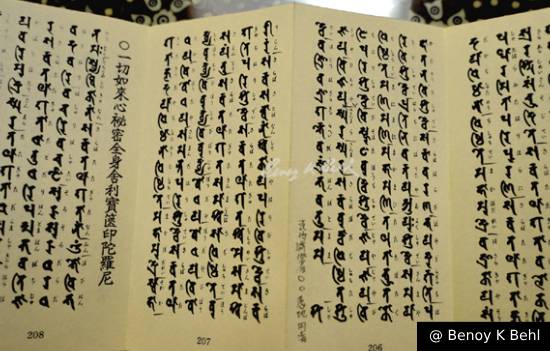 Sanskrit prayers and pronunciation in Japanese, Gokokuji, Tokyo. Photograph by Benoy K Behl.
Sanskrit prayers and pronunciation in Japanese, Gokokuji, Tokyo. Photograph by Benoy K Behl.
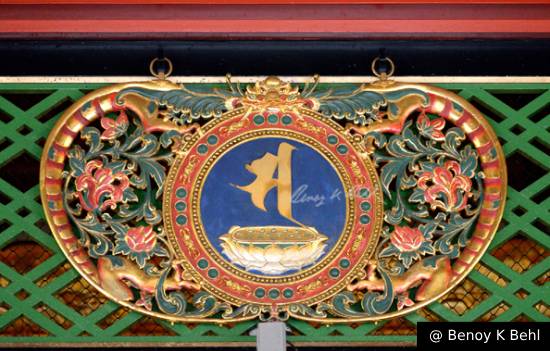 Sanskrit Beejakshara, Sensoji, Tokyo. Photograph by Benoy K Behl.
Sanskrit Beejakshara, Sensoji, Tokyo. Photograph by Benoy K Behl.
The mantras are in Sanskrit, as the
Japanese feel that translating them would destroy their effectiveness. The
pronunciation given in Japanese helps the priests to chant the mantras. There
is a deep relationship between Kana, the
Japanese alphabet and Sanskrit. The
Japanese wrote Sanskrit through simplified Chinese characters, which developed
into the Japanese alphabet, Kana. Accordingly, the structure of sounds of
Sanskrit and Japanese Kana are almost exactly the same.
Homa
Many links in the development of Vajrayana Buddhism can be found in a study of Japanese Buddhism. Today’s Himalayan Buddhism is of a later development and has lost the typical ‘havan’ or ‘homa’. I was delighted to find and to record the continuance of the tradition of ‘homa’ in some of the most important Japanese Buddhist sects, who call it ‘goma’. Sanskrit sutras are also chanted on the occasion and it is much like the ‘havan’ which we are all familiar with.
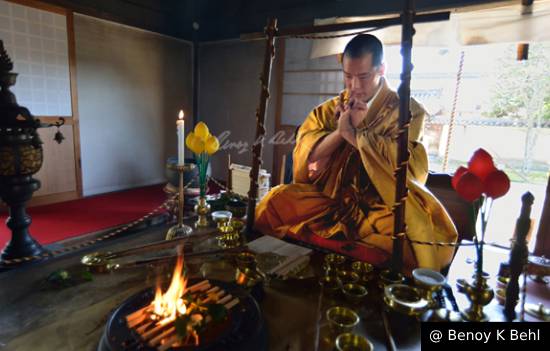 Havan or Homa, or Goma in Japan, Saidaiji Temple, Nara. Photograph by Benoy K Behl.
Havan or Homa, or Goma in Japan, Saidaiji Temple, Nara. Photograph by Benoy K Behl.
In the words of Prof Kitamura, “In Japan, they are preserving the old Indian tradition, because they are following the ancient scriptures. They are also doing the puja and the mudras, as well as the sadhna.”
 Havan or Homa, or Goma in Japan, Takahata Fudo Temple, Tokyo. Photograph by Benoy K Behl.
Havan or Homa, or Goma in Japan, Takahata Fudo Temple, Tokyo. Photograph by Benoy K Behl.
Goma in the Shingon and Tendai Buddhist sects of Japan has striking parallels with the early Hindu rites of Agni worship. There are also deep similarities with the later Tantric traditions. The havan is perhaps conducted in Japan, at least as often as in India. The tantric Shingon school of Japan sings Sanskrit hymns. To this day, followers of the sect perform their worship in 1,200 temples throughout Japan. In the words of His Excellency Mr. Yasukuni Enoki, Former Ambassador of Japan: “This should be recognized by the Japanese people that at the bottom of Japanese culture, Indian culture is very strongly imprinted. It is then developed in the Japanese way.”
Language
Very many words in the Japanese language are from Sanskrit. Sanskrit was also the basis for the formation of the Japanese alphabet ‘Kana’.
In the supermarkets, a major brand of milk products is called ‘Sujata’. The company personnel are taught the story of Sujata who gave sweet rice milk to the Buddha, with which he broke his period of austerity, before he gained Enlightenment.
Philosophy
There are deep meanings in Japanese
practices which take us back to early developments of philosophy in India. In
many ways, the philosophic understanding is most well preserved in Japan. Japan
has not had the breakdown of cultural norms which India suffered, when a
colonial education system was created. Therefore, most Indians learnt about our
own culture from the Western point of view. The dominant and admired language
was English, which it remains till today. Obviously, all our books and
education in schools and universities are rooted in the English vision.
Japan and India
Our relationship with Japan is far closer
than Indians seem to be aware of. It is time to understand this and to build
upon it. It is time, in fact, for the world to learn from the peaceful and
civilized outlook which is rooted in ancient India and in the culture of
countries like Japan. It is about time to stop destroying ourselves and the
world around us, through unthinking and uncaring commercialism.
People of “modern” outlook need not be concerned that looking to ancient culture will lead to less economic development. In fact, culture provides the discipline, meaning and concentration in life, which makes us truly successful in all that we do. What is more, it also leads to good health and happiness.
Japan is the one country where Buddhism is flourishing in all its facets. Here, technology and transcendence are living together. The deep-rooted spirit of Buddha’s teachings energies the Japanese people.
Buddhist temples are numerous and vast
numbers of people visit them every day. Besides the Buddha, so many ancient
Indian deities and practices are preserved in these temples. An Indian feels
quite at home in Japan.
Japan Foundation Fellowship
The research and most of these photographs,
were taken by me with the support of a Japan Foundation Fellowship, in Spring
2015. I am deeply grateful for this valuable support which was provided.
We now present pictures.
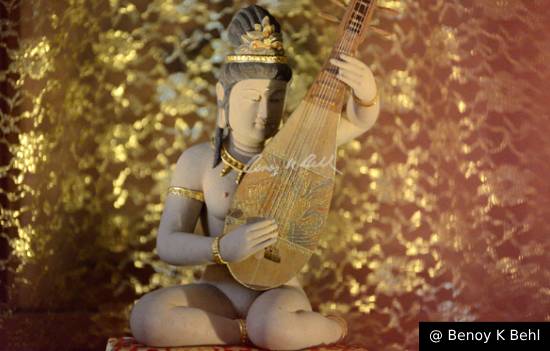 Saraswati, or Benzaiten, Yoshiwara Jinja, Tokyo. Photograph by Benoy K Behl
Saraswati, or Benzaiten, Yoshiwara Jinja, Tokyo. Photograph by Benoy K Behl
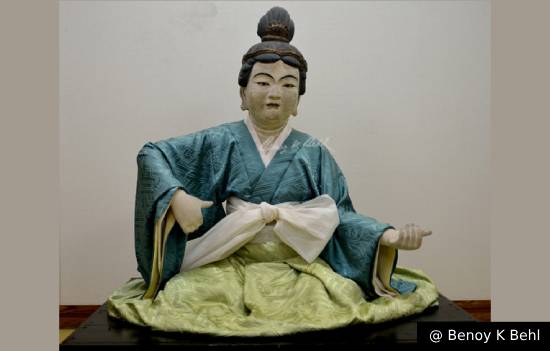 Saraswati, or Benzaiten, National Treasure Museum, Tsurugaoka Hachimangu, Kamakura. Photograph by Benoy K Behl
Saraswati, or Benzaiten, National Treasure Museum, Tsurugaoka Hachimangu, Kamakura. Photograph by Benoy K Behl
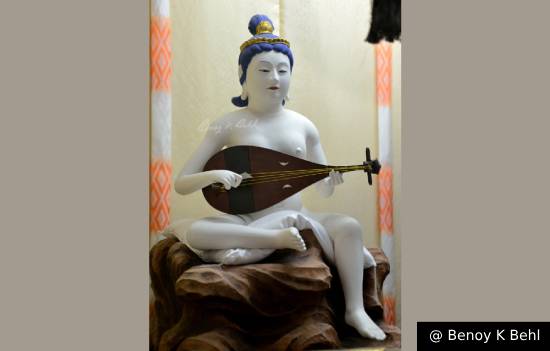 Saraswati, or Benzaiten, Enoshima Jinja, Kamakura. Photograph by Benoy K Behl
Saraswati, or Benzaiten, Enoshima Jinja, Kamakura. Photograph by Benoy K Behl
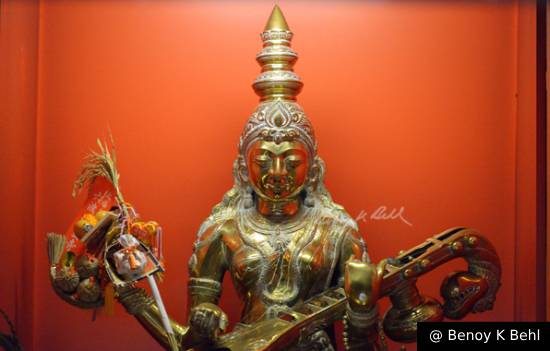 Saraswati, or Benzaiten, Rokuhara Mitsuji, Kyoto. Photograph by Benoy K Behl
Saraswati, or Benzaiten, Rokuhara Mitsuji, Kyoto. Photograph by Benoy K Behl
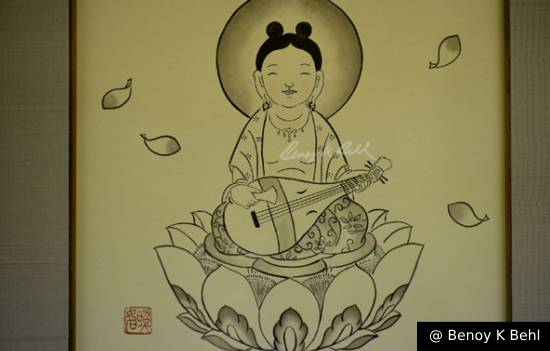 Saraswati, or Benzaiten, Rokuhara Mitsuji, Kyoto. Photograph by Benoy K Behl
Saraswati, or Benzaiten, Rokuhara Mitsuji, Kyoto. Photograph by Benoy K Behl
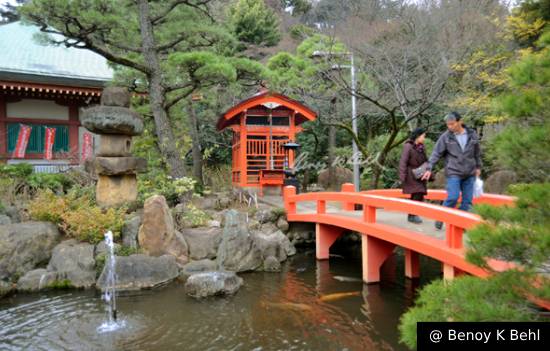 Saraswati, or Benzaiten Shrine, Takahata Fudo Temple, Tokyo. Photograph by Benoy K Behl
Saraswati, or Benzaiten Shrine, Takahata Fudo Temple, Tokyo. Photograph by Benoy K Behl
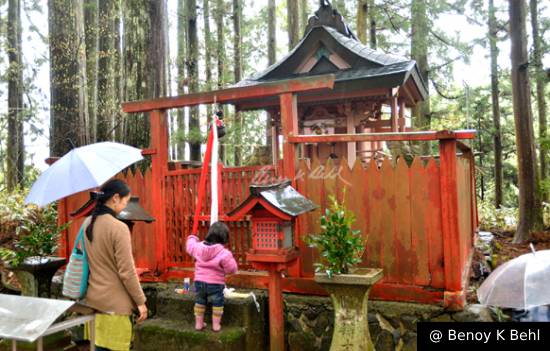 Saraswati, or Benzaiten Shrine, Koyasan. Photograph by Benoy K Behl
Saraswati, or Benzaiten Shrine, Koyasan. Photograph by Benoy K Behl
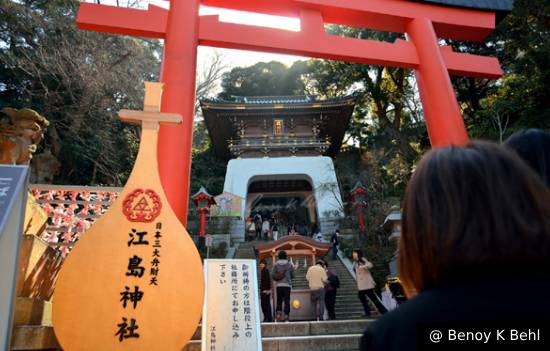 Saraswati's Veena, or Benzaiten’s Biwa, at entrance of Enoshima Jinja, Kamakura. Photograph by Benoy K Behl.
Saraswati's Veena, or Benzaiten’s Biwa, at entrance of Enoshima Jinja, Kamakura. Photograph by Benoy K Behl.
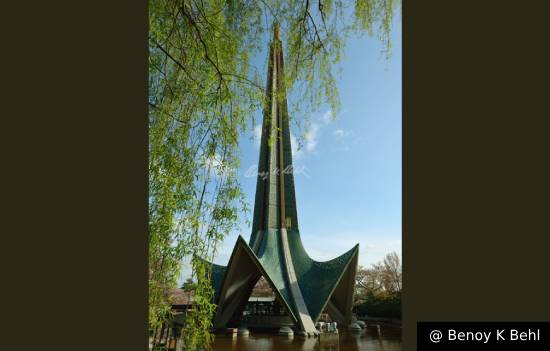 Saraswati or Benzaiten Shrine, Bentenshu, Osaka. This must be the most impressive and tallest shrine to Saraswati anywhere in the world today. Photograph by Benoy K Behl.
Saraswati or Benzaiten Shrine, Bentenshu, Osaka. This must be the most impressive and tallest shrine to Saraswati anywhere in the world today. Photograph by Benoy K Behl.
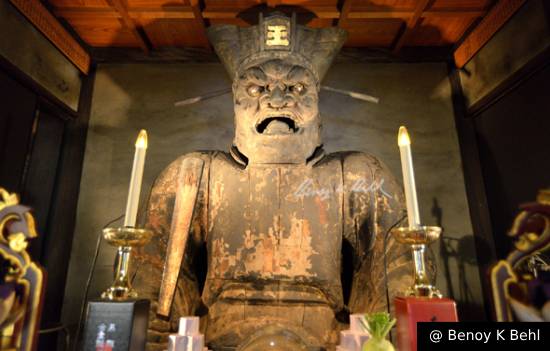 Yama, or Emma, Inoji, Kyoto. Photograph by Benoy K Behl.
Yama, or Emma, Inoji, Kyoto. Photograph by Benoy K Behl.
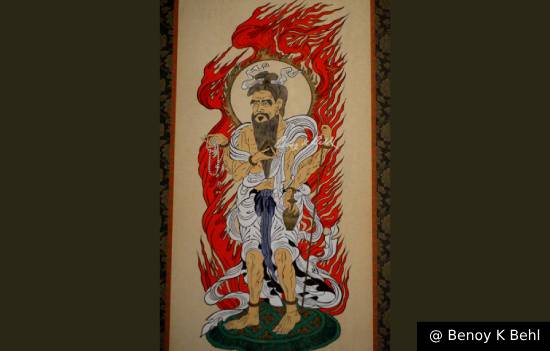 Agni, or Katen, Meguro Ryusenji, Tokyo. Photograph by Benoy K Behl.
Agni, or Katen, Meguro Ryusenji, Tokyo. Photograph by Benoy K Behl.
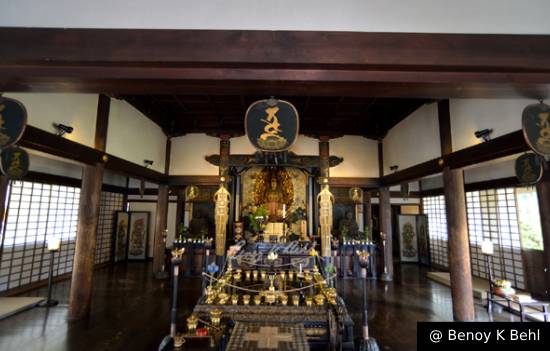 Beejakshara of Amitabha, Sanboin Hall, Daigoji, Shiga Prefecture. Photograph by Benoy K Behl.
Beejakshara of Amitabha, Sanboin Hall, Daigoji, Shiga Prefecture. Photograph by Benoy K Behl.
In Japan, they also use the Sanskrit
letters for writing the sacred syllables or Beejakshras, which have the power of
mantras. Every Buddhist monastery in Japan has a seal with a Beejakshara, a
sacred syllable, to use as a short name of the monastery.
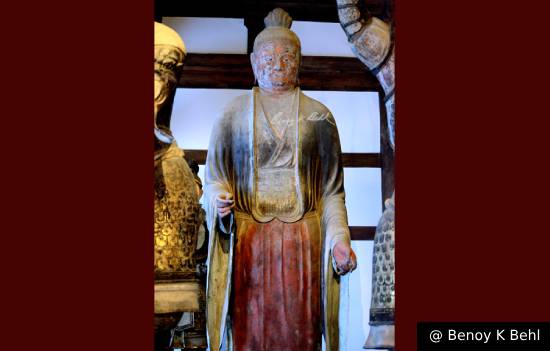 Brahma, or Bonten, Todaiji Temple, Hokkedo Hall, Nara. Photograph by Benoy K Behl.
Brahma, or Bonten, Todaiji Temple, Hokkedo Hall, Nara. Photograph by Benoy K Behl.
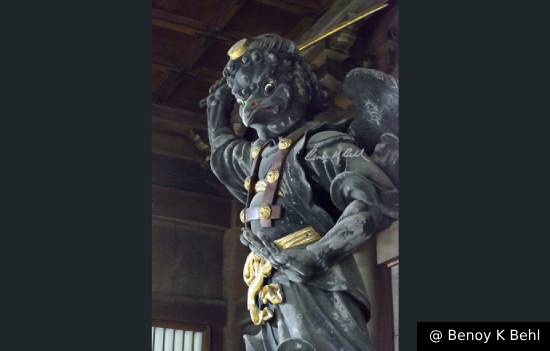 Garuda, or Karura, Daiyuzan-Saijoji, near Odawara. Photograph by Benoy K Behl.
Garuda, or Karura, Daiyuzan-Saijoji, near Odawara. Photograph by Benoy K Behl.
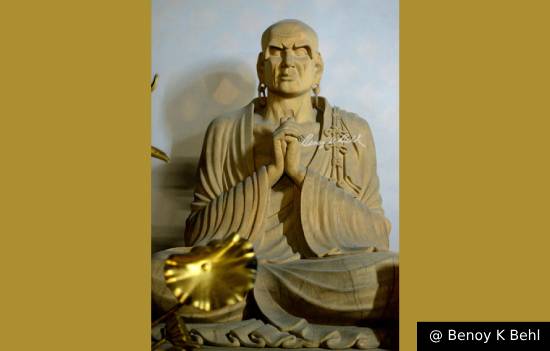 Bodhisena Statue, Ryosenji, Nara. Photograph by Benoy K Behl.
Bodhisena Statue, Ryosenji, Nara. Photograph by Benoy K Behl.
In the eight century, the Indian priest
Bodhisena was invited by the Japanese Emperor to Japan. He conducted the
eye-opening ceremony of great Buddha of the Todaiji temple in 752. Bodhisena is
believed to have been in South India.
 Varuna, or Suiten, Shibamata Taishakuten, or Daikyoji Indra Temple, Tokyo. Varuna is worshiped in numerous temples of Japan. Photograph by Benoy K Behl.
Varuna, or Suiten, Shibamata Taishakuten, or Daikyoji Indra Temple, Tokyo. Varuna is worshiped in numerous temples of Japan. Photograph by Benoy K Behl.
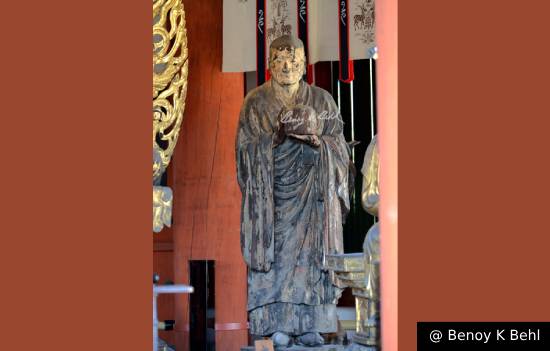 Asanga, Kofokuji Temple, Nara. Photograph by Benoy K. Behl.
Asanga, Kofokuji Temple, Nara. Photograph by Benoy K. Behl.
Asanga was a major exponent of the Yogacara
school of Buddhism in India. He is deeply venerated in Japan and this is one of
the very few statues in the world of Asanga.
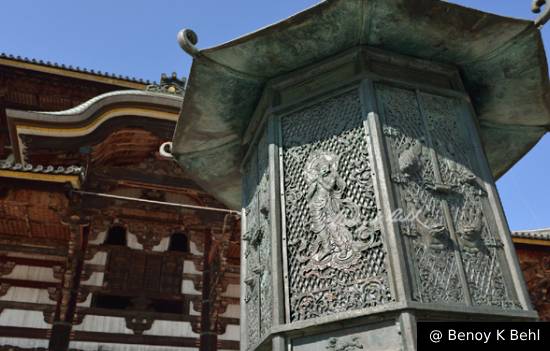 Figure like Krishna Venugopala, Todaiji Temple, Nara. Photograph by Benoy K Behl.
Figure like Krishna Venugopala, Todaiji Temple, Nara. Photograph by Benoy K Behl.
The philosophic imagery of India is fully
adopted by the Japanese. It is wonderful to come across almost all the
representations from Indian temples, here in Japan.
To read all articles
by author
To read all articles on Indian Influence Abroad
About the Photographer
Benoy K Behl is a film-maker, art-historian
and photographer who is known for his tireless and prolific output of work over
the past 48 years. He has taken over 53,000 photographs of Asian monuments and
art heritage and made 146 documentaries which are regularly screened at major
cultural institutions worldwide. His photographic exhibitions have been warmly
received in 74 countries around the world. These have been inaugurated by
ministers of the governments of various countries, ambassadors, archbishops, HH
the Dalai Lama and others dignitaries.
From 2001 till 2020 (when the last Lima Book of Records was published)
he has held the Limca Book Record for being the most travelled photographer and
art historian.
His films, including 26 documentaries on ‘The Paintings of India’, 26 documentaries on ‘The Sculpture of India’ and 26 documentaries on ‘Spectacular India’ have been nationally telecast on prime time in India, as well as repeat telecasts. These have also been screened at scores of universities and museums in several countries around the world.
India Habitat Centre, New Delhi screens one
film of Behl every month; the National TV channel DD Bharti has been showing a
film of his every day since 2001.
In January, 2008, National Geographic magazine carried an 18-page story about ancient Indian art revealed through Behl’s photography to the world. He is the first Indian about whose work National Geographic magazine have carried a story. BBC World News have also carried 3 major stories about Behl’s pioneering work in India and Vietnam.
The vastness of Behl’s documentation presents a wide and new perspective in understanding the art of India and Asia. His photography of ancient murals in remote places has clearly established the continuous tradition of painting in India, from ancient times through the medieval period. This is significant, as earlier, the Indian tradition of painting was believed to begin in medieval times.
Behl’s recent work on Yoga has made a notable contribution to the knowledge of the subject. To launch the International Day of Yoga in 2015, the Health Minister of India and the Director General of WHO jointly inaugurated Behl’s solo photographic exhibition on yoga, at the WHO Headquarters in Geneva. On all the International Days of Yoga, from 2015 to 2020, his exhibitions on yoga were held across the world. His films on Yoga were also shown in Indian Embassies and High Commissions around the world and he has been invited to lecture on Yoga in many countries.
Behl’s films, including on ‘Indian Roots of Tibetan Buddhism’ and ‘Indian Deities Worshipped in Japan’ have won several awards at international film festivals.
Behl has been invited to lecture by many of the important universities and museums around the world, who have departments of Asian art. He has delivered hundreds of lectures for 250 institutions in 36 countries. His book on ‘The Ajanta Caves’ is published by Thames & Hudson, London and Harry N. Abrams, New York. It has been in continuous print since 1998 and the latest edition has come out in 2023, which includes in it digital restoration of the masterpieces of Ajanta which Professor Behl has carried out. His recent books include ‘THE ART OF INDIA, Sculpture and Mural Painting’ in two volumes; ‘Buddhism: The Path of Compassion’ on the Buddhist heritage of the world, ‘Hindu Deities Worshipped in Japan’; ‘Buddhist Heritage of Andhra Pradesh’; Northern Frontiers of Buddhism’ and ‘Buddhist Heritage of Sri Lanka’.
On 21st October 2020 an acclaimed photograph of an Ajanta painting taken by Behl was archived in the ‘Arctic World Archive’, to be preserved in the memory of mankind.
In September 2021, his digitally restored
photograph of the earliest surviving Hindu painting, at Badami Caves, was also
preserved in the Artic World Archive.